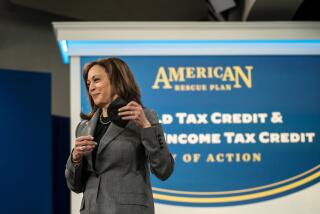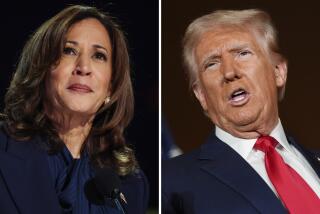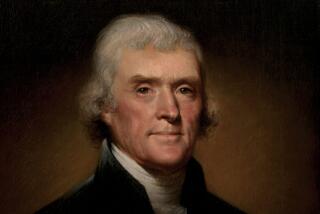Bush Offers Tax-Deferred Plan for Savings Accounts
- Share via
COLUMBUS, Ohio — Vice President George Bush, offering a program intended to help Americans “afford a home, pay for college or start a business,” proposed Tuesday that taxpayers with incomes less than $50,000 be allowed to defer paying income taxes on the interest produced in special $1,000 savings accounts.
The plan would reduce a saver’s tax bill by approximately $12 in its first year if the full $1,000 was set aside and slightly more in later years, according to one of Bush’s senior economic advisers, Michael J. Boskin, a Stanford University economist. The campaign said it would produce an initial loss to the U.S. Treasury, in deferred tax payments by 7 million to 8 million taxpayers, of $70 million, a figure that would rise to $550 million by 1993.
The proposal was the latest effort by Bush to tailor his appeal to the concerns of blue-collar and middle-class voters, and appeared to be a direct response to Democratic nominee Michael S. Dukakis’ repeated reference in recent weeks to the “middle-class squeeze” that Dukakis says has been created by the Reagan Administration’s economic policies.
In addition, Dukakis has been pressing his assertion that the only tax cut Bush favors is one trimming the tax on capital gains--a break that the Democratic nominee says favors the wealthiest citizens.
By encouraging savings, the program Bush presented is intended to help build funds to fuel future economic growth. The rate of personal savings in the United States is less than 4%, one of the lowest rates in the West.
“Americans have increasingly gotten away from the sensible frugality that says ‘put something away for a rainy day,’ ” Bush said.
Unveiling the plan in a speech at the Ohio State Republican Convention, whose participants applauded briefly when he discussed the proposal, Bush said:
“Savings is the flip side of investment. Investment creates jobs. The Bush savings plan will help keep this economic recovery going while making our future more secure.”
The Independent Savings Account that he proposed “is a building block for a better America,” he said.
Earlier in the day, Bush, in the midst of a Midwest campaign trip, sought to portray Dukakis as a liberal who was “just itching to start spending money” and one who “wants to set the clock back to those days of misery and malaise”--Bush’s shorthand for the Jimmy Carter Administration. He also made a brief stop in Owensboro, Ky., speaking to a rally on the bank of the Ohio River.
Arrived by River Boat
He reached Owensboro, a working-class city of 54,000, after a brief trip on the Executive Queen river boat. Each time reporters sought to question Bush about the savings plan, the boat’s horn obliterated any dialogue.
As described by Bush and his aides, the savings plan would work this way:
Taxpayers reporting up to $50,000 in adjusted gross income would be allowed to place up to $1,000 a year in special savings accounts. The interest earned would not be subject to taxes until it was withdrawn, provided the money was left in the account for at least five years. Bush described this as “tax-free,” although full taxes would eventually be due.
Thus, in an example cited by Boskin, if the account earned interest at the rate of 8% annually--thus producing $80 in interest in the first year--a saver paying taxes at the lowest rate, 15%, would be allowed to retain annually for five years the $12 in tax payments that would otherwise be due. When the money was withdrawn, after a minimum of five years, the accumulated interest earnings would be taxed.
Those earning adjusted gross incomes of $50,000 to $60,000 would be allowed to take part, but with reduced benefits.
Skeptical of Plan
Lyle Gramley, chief economist of the Mortgage Bankers Assn. and a former member of the Federal Reserve Board appointed by President Carter, expressed skepticism about the value of the plan, saying in a telephone interview that it would simply encourage people already saving money to move their funds--up to the allowable maximum of $1,000 a year--into the tax-deferred accounts. Thus, it would not increase the amount of money deposited in the nation’s savings institutions.
“All it is is a tax break for people with savings,” he said.
The plan is modeled after individual retirement accounts. When IRAs were introduced in the mid-1970s, individual taxpayers were permitted to place up to $2,000 a year of annual earnings in a special account where the invested money and its earnings could accumulate tax-free until retirement. (A 1986 tax code change removed the tax deduction for money deposited in the accounts for most upper-income taxpayers.)
Under Bush’s plan, the $1,000 deposited in the new accounts would not be tax-deductible. And unlike IRAs, there is not a higher limit for spouses filing jointly--couples would be limited to the same maximum level of $1,000.
Shorter Time Frame
One of Bush’s economic advisers, speaking on the condition of anonymity, said in Washington that “the main rationale” for the plan was that the IRAs require too long a commitment for some people and that Bush’s proposal was drawn up “to give people a more reasonable time period” and get them into the habit of saving money.
It also appeared to have been drawn up quickly. Aides traveling with Bush were hard-pressed to explain details of the program, and were forced to repeatedly tell reporters covering the vice president’s campaign to ask their questions of others on the campaign staff.
Craig Fuller, Bush’s chief of staff, acknowledged that although the amount of money on which tax payments would be deferred was small, “over a long period of time you can do reasonably well with it.”
Dukakis’ own staff calculated that the maximum benefit would be $20 a year, prompting the Massachusetts governor to disparage the savings plan by contrasting it with Bush’s earlier proposal for a capital gains tax cut.
“He (Bush) wants to give the wealthiest Americans a $30,000 tax break and the rest of us are going to get 20 bucks,” Dukakis said. “That, my friends, is a new definition of trickle-down. Twenty bucks a year--that’s Mr. Bush’s solution to the average American’s problems.”
Other Proposals
Before the general election campaign got under way, Bush advanced a number of tax and savings proposals, including his recommendation that the 28% capital gains tax be trimmed to 15%, a move the Congressional Budget Office has said would cut tax revenue by at least $4 billion a year.
More to Read
Get the L.A. Times Politics newsletter
Deeply reported insights into legislation, politics and policy from Sacramento, Washington and beyond. In your inbox three times per week.
You may occasionally receive promotional content from the Los Angeles Times.










